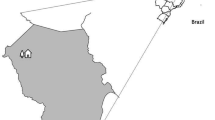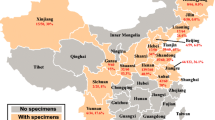Abstract
Serum samples from 489 male and female camels were tested for antibodies against Coxiella burnetii using indirect enzyme-linked immunosorbent assay (ELISA). Antibodies to C. burnetii were recorded in sera of 252 (51.64 %) camels. Significant differences in prevalence were found between male and female camels, juvenile and adult camels, and different ecotypes and different sampling locations. Three hundred seven camels were simultaneously tested for C. burnetii antibodies by ELISA and indirect immunofluorescence (IFA) tests. Close agreement was found between the results of the two tests. A high prevalence of C. burnetii antibodies was also recorded in milk samples tested by ELISA. Clinical samples from serologically positive camels were subjected to PCR analysis using primers which amplify the repetitive transposon-like and transposase gene regions of C. burnetii. Positive DNA amplification was obtained from both regions, with the highest shedding of C. burnetii in fecal samples (27.59 %) followed, in descending order, by urine (23.81 %), blood (15.85 %), and milk (6.5 %). The present results indicate that camels are a major reservoir of C. burnetii in Saudi Arabia. High prevalence of C. burnetii in camels, poor sanitary standards under which these animals are kept, and the consumption of raw camel milk indicate that camels can also be a major source of Q fever transmission to humans in Saudi Arabia.

Similar content being viewed by others
References
Abbas B, Yassin TTM, Elzubir AEA (1987) Survey for certain zoonotic diseases in camels in the Sudan. Rev Elev Med Vet Pays Trop 40:231–233
Aitkin ID (1989) Clinical aspects and prevention of Q fever in animals. Eur J Epidemiol 5(4):420–424
Al-Bashan MM (2011) In vitro assessment of the antimicrobial activity and biochemical properties of camel’s urine against some human pathogenic microbes. Middle-East J Sci Res 7(6):947–958
Alshaikh MA, Al-Haidary A, Aljumaah RS, Mohammed O, Alkurashi M, Gar Elnabi AR, Hussein MF (2007) Camel Brucellosis in Riyadh Region. Saudi Arabia J Camel Practice Res 14(2):113–117
Angen O, Stahl M, Agerholm J, Christoffersen AB, Agger JF (2011) Dynamics of relationship between the presence of Coxiella burnetii DNA antibodies and intrinsic variables in cow milk and bulk tank milk from Danish dairy cattle. J Dairy Sci 94:5750–5759
Berri M, Larcoucau K, Rodolakis A (2000) The detection of Coxiella burnetti from ovine genital swabs, milk and faecal samples by the use of a single touchdown polymerase chain reaction. Vet Microbiol 72:285–293
Berri M, Rousset E, Champion JL, Russo P, Rodokalis A (2007) Goats may experience reproductive failures and shed Coxiella burnetii at two successive parturitions after Q fever infection. Res Vet Sci 83:47–52
CDC (Centers for Disease Control and Prevention) (1997) Q fever outbreak—Switzerland. MMWR 33:355–356
Doosti A, Arshi A, Sadeghi M (2014) Investigation on Coxiella burnetii in Iranian camels. Comp Clin Pathol 23:43–46
Field P, Mitchell J, Santiago A, Dickeson D, Chan S, Ho D, Murphy A, Cuzzubbo A, Devine P (2000) Comparison of a commercial enzyme-linked immunosorbent assay with immunofluorescence and complement fixation tests for detection of Coxiella burnetii (Q fever). J Clin Microbiol 38(4):645–1647
Fretz R, Schaeren W, Tanner M, Baumgartner A (2007) Screening of various foodstuffs for occurrence of Coxiella burnetii in Switzerland. Int J Food Microbiol 116:414–418
Garcia-Perez AL, Astobiza JF, Atxaerandio R, Hurtado A, Juste RA (2009) Investigation of Coxiella occurrence in dairy sheep flocks by bulk-tank milk analysis and antibody level determination. J Dairy Sc 92:1581–1584
Gelpi AP (1966) Q fever in Saudi Arabia. Am J Trop Med Hyg 15:784–798
Guatteo R, Seegers H, Taurel AF, Joly A, Beaudeau F (2011) Prevalence of Coxiella burnetii infection in domestic ruminants: a critical review. Vet Microbiol 149(1–2):1–16
Gumi B, Ferdessa R, Yamuah L, Sori T, Tolosa T, Assefa A, Zinsstag J, Schelling E (2013) Seroprevalence of brucellosis and Q fever in southeast Ethiopian pastoral livestock. J Vet Sci Med Diag 2:1
Hussein MF, Alshaikh M, Gad El-Rab MO, Aljumaah RS, Gar El Nabi AR, Abdel Bagi AM (2008) Serological prevalence of Q fever and chlamydiosis in camels in Saudi Arabia. J Anim Vet Adv 7:685–688
Jung BY, Seo M, Lee S, Byun J, Oem J, Kwak D (2014) Molecular and serologic detection of C. burnetii in native Korean goats (Capra hircus coreanae). Vet Microbiol 204:152–155
Kardeňosa N, Sanfeliu I, Font B, Muňoz T, Nogueras MM, Segura F (2006) Short report: Seroprevalence of human infection by Coxiella burnetii in Barcelona (northeast of Spain). Am J Trop Med Hyg 75(1):33–35
Khorshid FA (2011) The cytotoxic effect of PM 701 and its fractions on cell proliferation of breast cancer cells, MCF7. Am J Drug Disc Dev 1:200–208
Kilic S, Pasa S, Babur C, Ozlem MB (2005) Investigation of Coxiella burnetii antibodies in sheep in Aydin region. Turkey Rev Med Vet 156(6):336–340
Klaasen M, Roest H, van der Hoek W, Goossens B, Secka A (2014) Coxiella burnetii seroprevalence in small ruminants in the Gambia. Plos One 9(1):e85424
Kovakova E, Gallo J, Shrameck S, Kazar J, Bergina R (1987) Coxiella burnetii antigens for detection Q fever antibodies by ELISA in human sera. Viro 31:254–259
Lippi M, Sebastiani A, El-Mutabakani H (1968) Detection of serum antibodies against reoviruses, adenovirus and C. burnetii in group inhabitants of Riyadh, Saudi Arabia. Arch Ital Sc Med Trop 49:129–136
Marrie TJ (1990) Epidemiology of Q fever. In: Marrie TJ (ed) The disease, vol 1. Fla: CRC Press, Boca Raton, pp pp 49–70
Mohammed OB, Jarelnabi A, Aljumaah RS, Alshaikh MA, Bakhiet Amel O, Omer Sawsan O, Alagaili AN, Hussein MF (2014) Coxiella burnetii, the causative agent of Q fever in Saudi Arabia: molecular detection from camel and other domestic livestock. Asian Pac J Trop Med 2014:715–719
Psaoulaki A, Hadjichristodoulou C, Loukaides F, Soteriades E, Konstantinidis A, Papastergiou P, Ioannidou MC, Tselentis Y (2006) Epidemiological study of Q fever in humans, ruminant animals and ticks in Cyprus using a geographical distribution system. Eur J Clin Microbiol Infect Dis 35:576–586
Rahimi E (2009) Coxiella burnetii in goat bulk milk samples in Iran. J Dairy Sci 92:1581–1584
Rahimi E, Doosti A, Ameri M, Kabiri E, Sharifian B (2010) Detection of coxiella burnetii by nested PCR in bulk milk samples from dairy bovine, ovine and caprine herds in Iran. Zoonoses Public health 57:38–41
Rehácek J, Brezina R (1968) Detection of Coxiella burnetii in saliva of experimentally infected ticks. Hyalomma dromedarii Koch. Bull World Hlth Org 39(6):974–977
Rodolakis A, Berri M, Hechard C, Caudron C, Souriau A, Bodler CC, Blanchard B, Camuset P, Devillechaise P, Natrop JC, Vadet JP, Arricau-Bouvery N (2007) Comparison of Coxiella brunetii shedding in milk of dairy bovine, caprine and ovine herds. J Dairy Sci 90:5352–5360
Rousset E, Berri M, Durnad B, Dafour P, Prigent M, Delcroix T, Touratier A, Rodolakis A (2009) Coxiella burnetii shedding routes and antibody response after outbreak of Q fever-induced abortion in dairy goat herds. Appl Environ Microbiol 75:428–433
Schelling E, Diguimbay C, Daoud S, Nicolet P, Boierlin P, Tanner M, Zinsstag J (2003) Brucellosis and Q fever seroprevalences of nomadic pastoralist and their livestock in Chad. Prev Vet Med 61:279–293
Schimmer B, Schotten N, van Engelen E, Hautvast ILA, Schneeberger PM, van Duijnhoven YTHP (2014) Coxiella burnetii Seroprevalence and Risk for Humans on Dairy Cattle Farms, the Netherlands, 2010–2011. Emerg Infect Dis 20:3
Soliman A, Boulos A, Botros M, Watts D (1992) Evaluation of a competitive enzyme immunoassay for detection of Coxiella burnetii antibody in animal sera. J Clin Microbiol 30(5):1595–1597
Waag DM (1997) Q fever. Lenhart, M. K. Medical Aspects of Biological Warfare. Washington D.C, In, pp 199–213
Wernery U, Kadan OR (1995) Infectious disease of camelids. Blackwell Wissenschafts Verlag, Berlin
Author information
Authors and Affiliations
Corresponding author
Rights and permissions
About this article
Cite this article
Hussein, M.F., Alshaikh, M.A., Al-Jumaah, R.S. et al. The Arabian camel (Camelus dromedarius) as a major reservoir of Q fever in Saudi Arabia. Comp Clin Pathol 24, 887–892 (2015). https://doi.org/10.1007/s00580-014-2002-y
Received:
Accepted:
Published:
Issue Date:
DOI: https://doi.org/10.1007/s00580-014-2002-y




